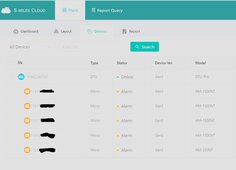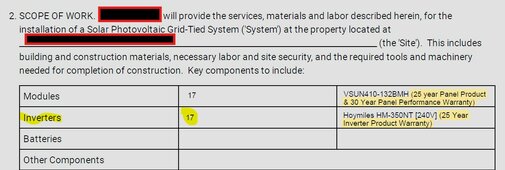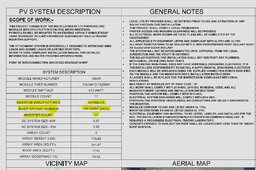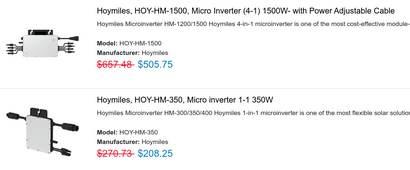Ok, got a new system installed yesterday. Per contract and all engineering/county permit paperwork was to have received 17 Hoymiles HM-350NT microinverters. (One per VSUN410-132BMH panel.)
Once they had finished and left I got my credentials from them for the Hoymiles app. I looked at the device list and saw that they installed 4 Hoymiles HM-1500NT (four panels each) and one 350NT for the 17th panel. I brought it to their attention earlier today just asking why they did that and what they propose as a resolution but have not received a reply as yet.
Aside from being dishonest and not at all in accordance with the paperwork they submitted for the permits (and presumably to my power company) how much of a fuss should I raise over this? Should I ask for a discount, insist they re-do it and/or (assuming they refuse) get quotes from other installers to correct and deduct from my payment, etc. I'd imagine the work involved with removing all the panels, buying the proper inverters, installing them and redoing all the wiring would be multiple thousands of dollars. (all they have so far is a 10% deposit)
Theoretically what they installed should actually have a slightly higher AC capacity. The contract and all paperwork list 5.93kW DC - all based on 17 350NT inverters - and oddly that's exactly what the Hoymiles app says despite the 4 1500s and 1 350 theoretically coming closer to 6.3kW.
I do know that should one of the 1500NTs fail I will lose production from 4 panels - ~25% of total generation - as opposed to ~6% should one of the intended 350NTs fail. That alone is a big downgrade. Beyond that are there any other reasons these 4 in 1 inverters are inferior to 1 per panel?
Other worries are electrical/wiring compliance/safety. Since the county approved this based on the 350NTs I have doubts that, since they used entirely different equipment, it was done safely or adequately. The inspector for the electrical was out yesterday and apparently passed it but he spent a mere 45 seconds on the roof and with the panels already installed he couldn't exactly count the inverters. I imagine he just assumed the design plans were what was installed and made sure the new electrical subpanel/disconnect on the outside wall and the inside panel looked right.
It is still pending the "building inspection" and whatever it is the power company looks at when they come out - I'd think it would fail the building inspection as it deviated so significantly from the approved plans but who knows. That inspector might just assume they installed what they were supposed to.
Ditto for the Hoymiles warranty. Their site implies to get warranty coverage (exchange/replacement) you need a detailed purchase receipt and design specs/diagrams. As mentioned there is zero paperwork that makes mention of the 1500NTs so they would certainly deny coverage based on no record of those being contracted for or submitted for permits/approvals.
Unfortunately the same people also installed my roof (I have no complaints on that) and most of their "lifetime labor/workmanship" warranties for both the roof and solar are well beyond what the manufacturer provides - so in that regard they kind of have me over a barrel since the more annoyed I make them the less likely they will ever actually meet those warranties,




Once they had finished and left I got my credentials from them for the Hoymiles app. I looked at the device list and saw that they installed 4 Hoymiles HM-1500NT (four panels each) and one 350NT for the 17th panel. I brought it to their attention earlier today just asking why they did that and what they propose as a resolution but have not received a reply as yet.
Aside from being dishonest and not at all in accordance with the paperwork they submitted for the permits (and presumably to my power company) how much of a fuss should I raise over this? Should I ask for a discount, insist they re-do it and/or (assuming they refuse) get quotes from other installers to correct and deduct from my payment, etc. I'd imagine the work involved with removing all the panels, buying the proper inverters, installing them and redoing all the wiring would be multiple thousands of dollars. (all they have so far is a 10% deposit)
Theoretically what they installed should actually have a slightly higher AC capacity. The contract and all paperwork list 5.93kW DC - all based on 17 350NT inverters - and oddly that's exactly what the Hoymiles app says despite the 4 1500s and 1 350 theoretically coming closer to 6.3kW.
I do know that should one of the 1500NTs fail I will lose production from 4 panels - ~25% of total generation - as opposed to ~6% should one of the intended 350NTs fail. That alone is a big downgrade. Beyond that are there any other reasons these 4 in 1 inverters are inferior to 1 per panel?
Other worries are electrical/wiring compliance/safety. Since the county approved this based on the 350NTs I have doubts that, since they used entirely different equipment, it was done safely or adequately. The inspector for the electrical was out yesterday and apparently passed it but he spent a mere 45 seconds on the roof and with the panels already installed he couldn't exactly count the inverters. I imagine he just assumed the design plans were what was installed and made sure the new electrical subpanel/disconnect on the outside wall and the inside panel looked right.
It is still pending the "building inspection" and whatever it is the power company looks at when they come out - I'd think it would fail the building inspection as it deviated so significantly from the approved plans but who knows. That inspector might just assume they installed what they were supposed to.
Ditto for the Hoymiles warranty. Their site implies to get warranty coverage (exchange/replacement) you need a detailed purchase receipt and design specs/diagrams. As mentioned there is zero paperwork that makes mention of the 1500NTs so they would certainly deny coverage based on no record of those being contracted for or submitted for permits/approvals.
Unfortunately the same people also installed my roof (I have no complaints on that) and most of their "lifetime labor/workmanship" warranties for both the roof and solar are well beyond what the manufacturer provides - so in that regard they kind of have me over a barrel since the more annoyed I make them the less likely they will ever actually meet those warranties,








